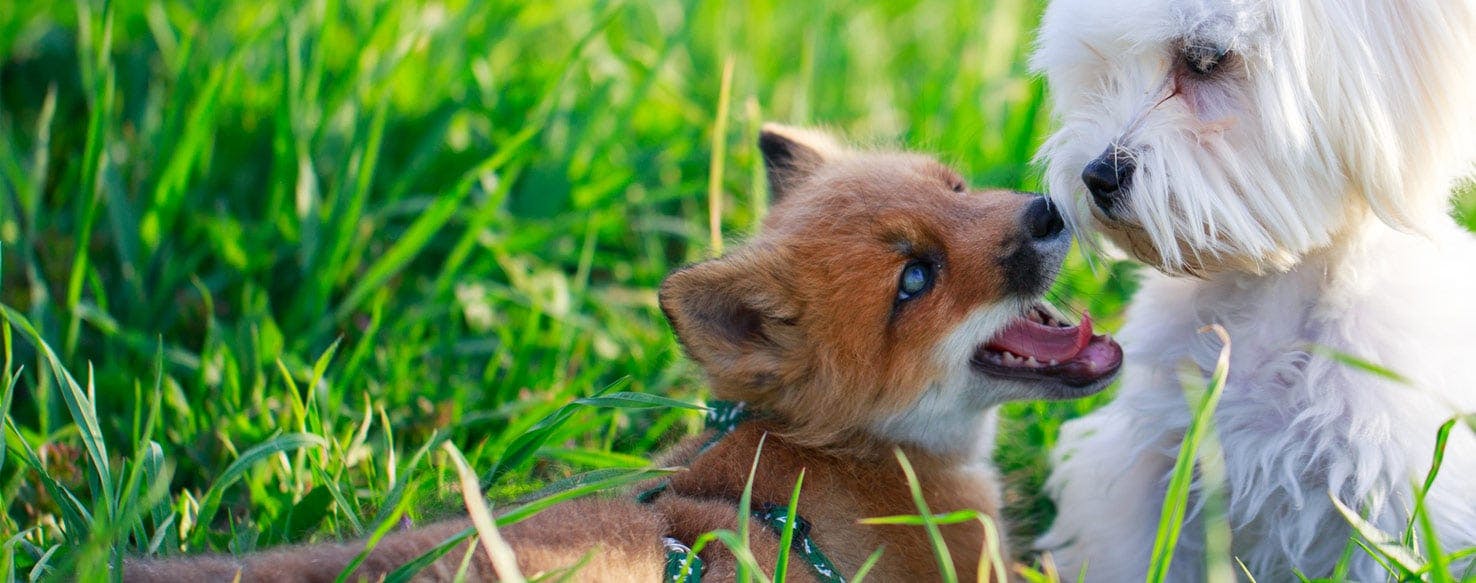- Home
- The Daily Wag!
- Behavior
- Why Dogs Don't Like Foxes
Why Dogs Don't Like Foxes

Common
Normal
Introduction
Your dog Baxter reminds you of a fox. He is a Pembroke Welsh Corgi with reddish fur, perky ears, and a short stature. He resembles a fox so much that you wonder if they are related. The strange thing is that Baxter has encountered a fox only a couple times and each time ran the other way and acted terrified of the creature. Yes, it appears that even though Baxter looks sort of like a fox, he despises the creature. Why is this? Out of curiosity, you decide to delve a bit deeper into the connection between foxes and dogs.
The Root of the Behavior
There are concrete reasons for Baxter’s similarities with foxes for dogs and foxes belong to the same animal family: Canidae, but then their DNA splits off from there, and many of their similarities end. Perhaps this is one reason why Dogs and foxes don’t tend to get along. Foxes are usually smaller than dogs and have flatter skulls. They are also difficult to potty train, and they only live 2-4 years, compared to a dog’s 10-14 years. Additionally, foxes are not nearly as affectionate towards humans as your loving Baxter. They also have a nasty scent, which is not appealing to dogs. Although most foxes will stay clear of your pooch, young fox cubs are the most likely to attack and kill small dogs—when they are learning to hunt—and have not yet fully developed a fear of humans and other animals. The relationship between most dogs and foxes may also be strained because they both are very territorial and will leave their scents in their designated territory. In other words, neither animal wants to have the other invade his territory, and an overlap with a fox and dog could cause disagreements if they both want to be in Baxter’s doghouse. Unfortunately, some neighborhood foxes on the prowl could also be infected with rabies. Baxter is not really into being friendly with animals that are foaming at the mouth. Since foxes are wild creatures, they also carry some diseases and parasites that Baxter might not be familiar with, and he may instinctively know to keep his distance. Some dogs aren’t even social fans of their own kind, so it is not surprising that Baxter does not want to run and play with a fox. It is also probably a good thing since foxes can carry diseases and are territorial. Foxes and domesticated dogs also have completely different lifestyles and mindsets. No longer is Baxter hunting and seeking shelter to survive; in fact, compared to the wild fox, Baxter is quite spoiled and is not going to be seeking such essential survival needs as the fox that he comes into contact with.
Need advice about your pet's health?
Get answers fast from a veterinary professional 24/7 in the Wag! App.
Get Vet ChatEncouraging the Behavior
Dogs are not usually at risk from foxes unless the fox is rabid or carrying disease. (This is difficult to know though, so dogs should keep their distances.) Very small puppies are more at risk than larger dogs because; in rare cases, foxes have preyed on these vulnerable, innocent canines. It’s also a good idea for Baxter to stay clear of foxes because being scratched or bitten by this wild animal could result in sickness or infection for Baxter. Make sure that you take your dog to the vet immediately if he is wounded by a fox or any other wild animal for that matter. Foxes also may have contaminated feces that is not good for Baxter either. Foxes do not usually see dogs as prey, but both animals are carnivores and may fight over food, if they come into contact with one another. This is why it is important that humans take actions to prevent foxes from coming near their houses by securing garbage in a proper location and not feeding foxes, if they do see one. On the other end, there are instances when dogs and foxes have formed healthy bonds, such is the case in Norway with Tinni the dog and Sniffer the fox who met by chance in the woods and became playmates. But this is out of the ordinary, and you may want to play it safe and save the playdates for the dog park.
Other Solutions and Considerations
The most common-sense solution to avoiding a dog and fox fight is to make sure that they do not come into contact with one another. This is quite possible if owners remove temping garbage and food from the outdoors. Owners should be more protective if they have puppies and live in an area known for having foxes. Owners should also bring their furry friends to the vet, if a fox ever scratches or bites their dog. It’s important to be aware that foxes are wild animals and have different needs and are capable of harboring different diseases and parasites than Baxter may be used to. Some owners may live in an area where foxes are not even prevalent, and do not have to worry about this issue.
Conclusion
Luckily, you do not have foxes hanging out while you are having your Sunday barbeque, but you have seen a few come by now and then. Baxter does a good job of keeping his distance, and you don’t foresee a dog and fox fight soon. Still, you make sure to clean all scraps after your barbeque and bring all trash inside, and if you did happen to see a fox, you certainly know not to entice it with your famous chicken recipe. After the barbeque is over, you and Baxter plan on going inside and sitting on the couch where there are absolutely no foxes at all.
Written by a Shiba Inu lover Patty Oelze
Veterinary reviewed by:
Published: 02/09/2018, edited: 01/30/2020
More articles by Patty Oelze
